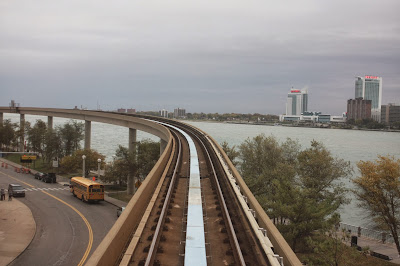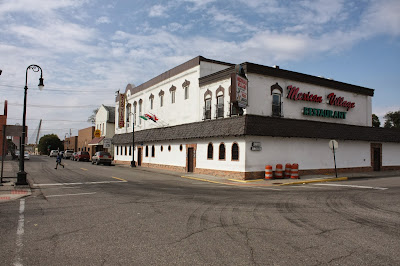If Wikipedia had existed in the 1950s, you could have read about Detroit being the fourth largest city of the Unites States with almost 2 million inhabitants. Today, Wikipedia says that Detroit is the 18th largest city in the States with less than 700,000 inhabitants and that it became the largest U.S. city to file for bankruptcy in July 2013. What an impressing decline. And what a good reason for Gunnar (sociologist) and me (city geographer) to visit this city.
A lot has been written about Detroit’s decline (for example this brief abstract, or the very good article “Ruinen-Porno” in DER SPIEGEL 43/2013), a lot has been done to reanimate the city’s economy, buildings and streets. How does the city look like? Is it really a dangerous ghost town? Is there nothing beautiful left in Motown? Or do all the people who warned us of doing this trip exaggerate because they’ve never been in Detroit and only hear the bad news about it? Honestly: yes, they did. Some parts of downtown Detroit are still beautiful; the whole city is absolutely interesting; isn’t it great to have a museum-like inner city with run-down buildings that - in a better shape – could also stand in Manhattan or Chicago’s Loop? Isn’t this empty freeway part of the car-free inner city we’re thinking about as a healthy solution for the future? On the other hand, Detroit is of course dangerous. Statistically, one person was killed during our stay in the city. Interestingly, the local newspaper used more space for the Halloween-dressed monsters at a car wash than for the murder that happened in a drive through the day before our visit.
A lot of questions arose during our visit. Can the decline of America’s car industry really be held responsible for the decline of a whole metropolis? Or is the neo-liberal American way of city governance to blame for the decline of Detroit? How could you successfully reanimate the downtown core? Will Wolfsburg look like Detroit once oil had become so expensive that we can’t burn it anymore in ways that destroy our planet?







“Do you want to get out at the Renaissance Center?” – “Yes, please. Do you know if there’s somewhere a Tim Horton’s or Starbucks where we can have a breakfast?” – “There’s no Tim Horton’s in the States. There used to be a Starbucks in the Renaissance Center, but it’s closed now.” – “So ‘welcome to Detroit’?” – “Yes, exactly.” We said goodbye to the laughing bus driver and found ourselves in a terribly cold, windy, dark city (why is it still dark at half past seven? Is Detroit always dark? Or is it just because is it 400 km west of Toronto?). Since we stepped off the Greybound bus in Windsor at 5:24 AM, it hasn’t become any warmer. The newspapers says it is (converted from Fahrenheit) 3°C, with a “RealFeel” of -5°C. It indeed feels like -5°C.
The people mover doesn’t start service before 9 AM, so we entered the Renaissance center, a complex of office towers that also includes the global headquarters of General Motors. The Renaissance Center was erected in 1977 and renovated in 2004. The project was intended to revitalize the economy of Detroit…
Nathaniel, a friendly homeless person, showed us where we can find a food court – and indeed, there were McDonald’s and Burger King in the basement. We invited Nathaniel for breakfast and talked to him about Detroit’s city developments (he is convinced the city is on a good way to recover) and the latest iPhone models.


The observation desk doesn’t open before 5 PM, we didn’t see anything but hotel room doors of the “Detroit Marriott at the Renaissance Center” on the 58th floor, which we reached using a strange, shaky elevator. According to Wikipedia, the 1,298-room hotel is located in the tallest all-hotel skyscraper in the Western Hemisphere.
In the basement, we later visited the “GM World exhibit”, a selection of General Motors cars.


This big fat American car…

…makes only a 2nd rank in the fuel economy & greenhouse gas rating – it emits 581 gram CO2 per mile!

This modern electric vehicle…

…has been assembled in Korea, only 8% of its parts content has a North American origin.

Before we finally left the Renaissance Center for the People Mover, we had a closer look at this city model.


As you can see in this video, it was still windy outside.
The Detroit People Mover runs along a 4,7 km long loop encircling Detroit’s Downtown. The system – comparable to Vancouver’s SkyTrain and Toronto’s Scarborough RT – was designed to move up to 15 million riders a year. Its actual ridership is about 7,000 people a day (Gunnar and I were alone in the car), it costs 12 million $ subsidies per year. No, it is not a success story. But it is a great tourist attraction. That’s what you can see out of the window:









Unlike Toronto, in Detroit you can find schedules for particular bus routes and a digital display with real-time departure times at the central bus station. The central bus station (“Rosa Parks Transit Center”) is quite modern and well designed, but public transport users in Detroit are obviously not part of the middle or upper class. And not all the people in the bus station are users of the public transport, but beneficiaries of the heating in the building…

We were users of the public transport, as we wanted to see the Beaux-Arts Michigan Central Station, probably the most famous ruin in Detroit. Erected as the tallest rail station in the world in 1913, it was Detroit’s passenger rail depot until the cessation of Amtrak service in 1988. Although it is a Priority Cultural Site and there are over and over again initiatives to renovate the building, its future remains undetermined. Do you have an idea what to do with this building? Share it on this website!



As you can see on the pictures, also the area around the former railway station is not in a perfect condition…





The best schedule doesn’t help if the buses don’t run. On the way from downtown to the old Michigan Central Station, we had a very friendly bus driver. But she was our only bus driver in Detroit: there was never a bus going back to the city center. Having waited 20 minutes for the “between 12:02 and 12:07 bus”, we decided to enter the Mexican restaurant at the corner (we’ve been in the “Mexican village”) for a hot tea. Back at the bus stop, also the “between 1:07 and 1:12 bus” (yes, the city buses on line 49 are running every 65 minutes…) did never arrive. So we finally decided to walk back to downtown. Using the skyscrapers as a compass, we found a much shorter way than the bus had taken and passed some beautiful and/or interesting buildings. As the pictures show, the weather had turned better. But it was still cold; without gloves and headband it would have been really hard…




We didn’t trust the transportation system anymore, that’s why we skipped our planned trip to 8 Mile Road in order to make sure that we catch the train from Windsor back to Toronto (you never know how much time the border control will take…). Instead, we explored other parts of downtown – where we found positive signs of (re)development, (re)investment and hope – and enjoyed the awesome food at a Greek restaurant in Greektown. I could never afford a restaurant like this in Toronto. In Detroit we paid 13$ each for a combined lunch+dinner, including a drink.





In the narrow tunnel under the river we passed again the border and came back to Canada. There we were surprised by what we already took for granted in Toronto in the last weeks: everything is so clean; no garbage on the sidewalks; many pedestrians; not many homeless people; people of color are driving the same type of (much too big…) cars as white people; cafés, shops and restaurants all over; most of the buildings in a good condition. The rest of the world always thinks that Canada is a kind of heaven on earth. Having experienced Toronto’s public transit, read about its increasing income disparities, knowing the decisions of its mayor, and suffering its price level, we didn’t believe this anymore. But coming back from Detroit, looking back to this failed liberal adventure playground on the other side of the river, we rethink if Canada is after all indeed heaven on earth.








Note for non-geographers: the title of the post refers to Jane Jacobs's most famous book.
Great post, Markus! Always hearing and reading about the derelict condition of Detroit I wonder if there are any neighbourhoods you would describe as worth to live in? I mean there are people still living in the city, working, spending leisure time. Is there any nucleus of "urban life" somwewhere around or is it all too dispersed to speak of something like that?
AntwortenLöschenMiddle class and upper class neighbourhoods cannot be found downtown, the people working in the edge cities are also living in former suburbs that are today cities. But you can see places of hope and change also in Detroit's downtown: renovated buildings, new cafés and shops, construction sites. There is definitely some development happening, but you never know how sustainable it is as there happens some new development (Renaissance Center, Sport Stadiums, People Mover, ...) every other decade, so far without bringing downtown back on track.
Löschen